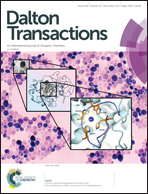The crystalline α,ω-dicarboxylate metal complex with the longest aliphatic chain to date: uranyl 1,15-pentadecanedioate†
Abstract
Under solvo-hydrothermal conditions, 1,15-pentadecanedioic acid (H2C15) reacts with uranyl ions to form the complex [H2NMe2]2[(UO2)2(C15)3] (1), in which the uranyl ions are tris-chelated by carboxylate groups and the well-ordered aliphatic chains are either all-trans or kinked. 1 crystallizes as a two-dimensional network of the bilayer type and with the {82·10} point symbol, the packing displaying alternate sheets containing either the ionic parts or stacks of aliphatic chains, at variance with the helicates or honeycomb networks previously obtained with other long-chain HOOC–(CH2)n−2–COOH dicarboxylic acids (n = 9–13) and bulkier counterions.



 Please wait while we load your content...
Please wait while we load your content...